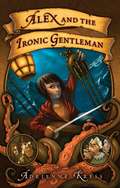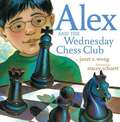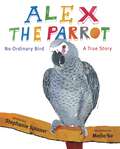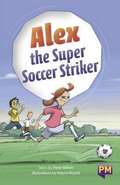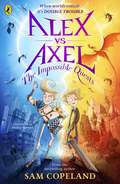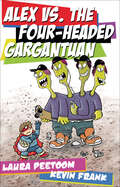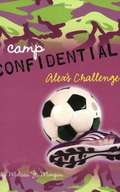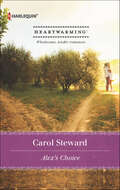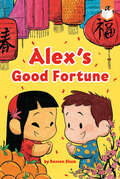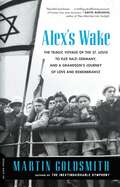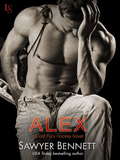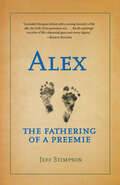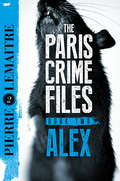- Table View
- List View
Alex and the Ironic Gentleman
by Adrienne KressOften mistaken for a boy because of her haircut and name, Alex Morningside is an inquisitive girl of ten-and-a-half who attends the prestigious Wigpowder-Steele Academy. Unfortunately, though she loves to learn, Alex just can't bring herself to enjoy her classes. Her teachers are all old and smelly and don't seem to know about anything that has happened in the world the past thirty years, and her peers...well they are quite simply ridiculous. Luckily for Alex, the new school year brings an exciting new teacher. Mr. Underwood makes lessons fun and teaches her how to fence. But Mr. Underwood has a mysterious family secret - the swashbuckling and buried treasure kind - and not everyone is glad he has come to Wigpowder-Steele. When the infamous pirates of a ship called the Ironic Gentleman kidnap Mr. Underwood, Alex sets off on a journey to rescue him, along the way encountering a cast of strange and magical characters, including the dashing and sometimes heroic Captain Magnanimous, Coriander the Conjurer, the Extremely Ginormous Octopus, and the wicked Daughters of the Founding Fathers' Preservation Society.
Alex and the Wednesday Chess Club
by Janet S. WongAlex first learned to play chess when he was four years old. He loved it. He loved the pieces, the challenge, and the sweet taste that winning left in his mouth. He loved it until he played a chess game with moldy old Uncle Hooya... and lost. Then Alex decided to give up chess for good. Now in third grade Alex wants to give chess another try. He joins the chess club and discovers that chess is fun again. He plays his friends, he listens to the coach, and he practices at school, at home, and on the computer. Alex is a chess maniac! All of this practice is leading up to the big tournament, where Alex finds himself face-to-face with Little Cousin Hooya. Memories of his earlier defeat return, but now is his chance to finally beat a Hooya. Is Alex up to the challenge? Janet Wong's lyrical text will inspire chess players of all ages to practice, practice, practice -- and to avoid moldy old Uncle Hooya!
Alex the Knight
by Patrick GrahamAlex is a noble, adventurous, and brave knight who lives in the enchanting Kingdom of Síscéal. Like all brave knights, Alex the Knight swings a mighty sword while reveling in a life full of action-packed quests – from finding glass slippers to stopping super wicked and evil witches from harming the innocent. However, even though Alex the Knight enjoys the thrill of adventure, there is one thing the brave knight desires more than anything else in the world. With unwavering determination and a heart filled with hope, Alex the Knight embarks on an incredible journey, venturing into the magical world in pursuit of Alex’s deepest desire.
Alex the Parrot: A True Story
by Stephanie SpinnerIn 1977, graduate student Irene Pepperberg walked into a pet store and bought a year-old African grey parrot. Because she was going to study him, she decided to call him Alex--short for Avian Learning EXperiment. At that time, most scientists thought that the bigger the brain, the smarter the creature; they studied great apes and dolphins. African greys, with their walnut-sized "birdbrains," were pretty much ignored--until Alex. His intelligence surprised everyone, including Irene. He learned to count, add, and subtract; to recognize shapes, sizes, and colors; and to speak, and understand, hundreds of words. These were things no other animal could do. Alex wasn't supposed to have the brainpower to do them, either. But he did them anyway.Accompanied by Meilo So's stunning illustrations, Alex and Irene's story is one of groundbreaking discoveries about animal intelligence, hard work, and the loving bonds of a unique friendship.
Alex the Super Soccer Striker (Into Reading, Level O #66)
by Peter Millett Wayne BryantNIMAC-sourced textbook <p><p> Alexandra is very nervous about starting at a new school. She wants to be chosen for the first eleven of the soccer team. But she is the only girl at the trials. Will Alex find her confidence in time to become a super soccer striker?
Alex vs Axel: The Impossible Quests (Alex vs Axel)
by Sam CopelandThe hilarious new fantasy adventure from the author of Charlie Changes Into a Chicken.Alex is a normal, everyday kid, living in a normal, everyday city. Axel is a monster-slaying hero, living in a world of magic. Unfortunately, when the two boys mysteriously swap places, each of them ends up being mistaken for the other.With zero experience of heroism, Alex is thrust into an epic quest to defeat the evil Felonius Gloam, who has stolen the Book of Lifetales and is using it to unravel the very fabric of the world of Aërth.Meanwhile, Axel is faced with double maths, a gran who's six months behind on the rent, and a crucial chess tournament he's got to win – when he doesn't even know how to play.Can the two boys complete their Impossible Quests and find a way back to their own lives, or will they both discover they don't have a life to come back to . . . ?
Alex vs. the Four-Headed Gargantuan (Lorimer Illustrated Humor)
by Laura PeetoomAlex gets a paper route, dreaming of the money he will make and how he will spend it. But it's more work than he bargained for. Not only does he have to figure out how much money he gets to keep, but he also has to face dangers like the savage Yapper Snapper and the dreaded Four-Headed Gargantuan. Illustrated comic-book-style with the adventures of Alex's superhero alter ego, this book shows how Alex learns that his real riches are courage and kindness. Distributed in the U.S by Lerner Publishing Group
Alex's Challenge #4
by Melissa J. MorganIt's Alex Kim's fourth year at Camp Lakeview, so there's nothing mysteriousabout her. Everyone knows that she's a star athlete and an all-around leader, and if they don't, never-shy Alex will be more than happy to fill them in. But Alex is holding something back this summer, and her friends are beginning to notice. Can they figure out what's been bothering their friend before the summer ends?
Alex's Challenge (Camp Confidential #4)
by Melissa J. MorganDuring the last weeks of summer camp, eleven-year-old Alex Kim has trouble hiding a secret from the other girls in bunk 3C while also trying to meet the high standards she sets for herself in sports, relationships, and other activities.
Alex's Choice
by Carol StewardAn unexpected fireKatarina Berthoff had everything planned out. Her business was developing well, and her stable boyfriend would propose in eight weeks, according to his timetable. Then smoke jumper Alex MacIntyre-Katarina's teenage crush-reentered her life. Alex was kind and romantic and just as handsome as she remembered. And he was definitely not part of the plan.Things weren't exactly going as Alex expected, either. He'd left smoke jumping only temporarily to help his brother Kevin run his construction business. Eventually he would be going back to his dangerous calling as a firefighter. There was no place in that life for a vivacious and beautiful woman who also happened to be practically engaged. But Alex couldn't deny that he liked the regular hours in construction, being there for family get-togethers...and coming home to Katarina. Which meant he had a choice to make-and so did she.
Alex's Good Fortune
by Benson ShumCelebrate Chinese New Year with this sweet story of friendship and family!In this story designed to engage early readers, charming characters combine with simple text, lively illustrations, and laugh-out-loud humor to help boost kids' confidence and create lifelong readers!Chinese New Year is the most important holiday for Alex and her family, so it's even more special when she gets to share her favorite traditions with her best friend, Ethan. Together, they join the Chinese New Year parade and get to help make the dragon dance. Then they prepare for the festivities by tidying up, decorating, and making dumplings. After that, it's time to open red envelopes, eat a great big feast, and enjoy the lantern fesival! Complete with fun facts about the holiday in the back of the book, young readers will want to revisit this story again and again. Exciting, easy-to-read books are the stepping stone a young reader needs to bridge the gap between being a beginner and being fluent.
Alex's Law
by Jayce EllisAlex Corrigan is in love with his boss, Judge Lawson Daniels, and thinks those feelings are returned. That assumption is sorely tested two days before the court holiday party they're organizing together, when the venue calls and cancels, followed by a snafu with the caterer. Alex could handle that, but after an intimate dinner followed by a decidedly unromantic e-mail, he's left wondering about the future of his employment as well as his relationship with the debonair older man. Law can't wait to see his clerk again. But Alex is cold and distant in the light of day, and Law doesn't understand. The party looms in the background, but Law's excitement is turning to dread. On top of that, someone is sabotaging them, trying to get Alex fired and drive Law off the bench. If there's any chance for a happy holiday for Alex and Law, they'll have to find out who.
Alex's Triple Treat (10th Anniversary Edition)
by Nancy Simpson Levene3 Alex books: Shoelaces and Brussels Sprouts, Peanut Butter and Jelly Secrets, and T-Bone Trouble.
Alex's Wake: The Tragic Voyage of the St. Louis to Flee Nazi Germany-and a Grandson’s Journey of Love and Remembrance
by Martin GoldsmithAlex's Wake is a tale of two parallel journeys undertaken seven decades apart. In the spring of 1939, Alex and Helmut Goldschmidt were two of more than 900 Jewish refugees fleeing Nazi Germany aboard the St. Louis, "the saddest ship afloat" (New York Times). Turned away from Cuba, the United States, and Canada, the St. Louis returned to Europe, a stark symbol of the world's indifference to the gathering Holocaust. The Goldschmidts disembarked in France, where they spent the next three years in six different camps before being shipped to their deaths in Auschwitz.In the spring of 2011, Alex's grandson, Martin Goldsmith, followed in his relatives' footsteps on a six-week journey of remembrance and hope, an irrational quest to reverse their fate and bring himself peace. Alex's Wake movingly recounts the detailed histories of the two journeys, the witnesses Martin encounters for whom the events of the past are a vivid part of a living present, and an intimate, honest attempt to overcome a tormented family legacy.
Alex, Approximately
by Jenn BennettBailey “Mink” Rydell has met the boy of her dreams. They share a love of films and talk all day – Alex is perfect. Well, apart from the fact that they’ve never actually met… and neither of them knows the other’s real name. When Bailey moves to California to live with her dad, who happens to live in the same town as Alex, she decides to use her sleuthing skills to find him. But tracking someone down based on online conversations alone proves harder than Bailey thought, and with her irritating but charismatic colleague Porter Roth distracting her at every turn, will she ever get to meet the mysterious Alex? From the author of Night Owls comes a story of summer, first love and hidden identities...
Alex, Approximately: A Novel
by Jenn BennettIn this delightfully charming teen spin on You&’ve Got Mail, the one guy Bailey Rydell can&’t stand is actually the boy of her dreams—she just doesn&’t know it yet.Classic movie buff Bailey &“Mink&” Rydell has spent months crushing on a witty film geek she only knows online by &“Alex.&” Two coasts separate the teens until Bailey moves in with her dad, who lives in the same California surfing town as her online crush. Faced with doubts (what if he&’s a creep in real life—or worse?), Bailey doesn&’t tell Alex she&’s moved to his hometown. Or that she&’s landed a job at the local tourist-trap museum. Or that she&’s being heckled daily by the irritatingly hot museum security guard, Porter Roth—a.k.a. her new arch-nemesis. But life is whole lot messier than the movies, especially when Bailey discovers that tricky fine line between hate, love, and whatever-it-is she&’s starting to feel for Porter. And as the summer months go by, Bailey must choose whether to cling to a dreamy online fantasy in Alex or take a risk on an imperfect reality with Porter. The choice is both simpler and more complicated than she realizes, because Porter Roth is hiding a secret of his own: Porter is Alex…Approximately.
Alex, You're Glowing! (The Secret World of Alex Mack #1)
by Diana G. GallagherIt's Alex's 1st day of junior high and everything goes wrong! She can't decide what to wear. Her mother packs her lunch in a Troll lunchbox.
Alex: A Cold Fury Hockey Novel (Carolina Cold Fury Hockey #1)
by Sawyer BennettNew York Times bestselling author Sawyer Bennett scores big-time with the first novel in a sexy new series hot enough to melt the ice. Hockey star Alexander Crossman has a reputation as a cold-hearted player on and off the rink. Pushed into the sport by an alcoholic father, Alex isn't afraid to give fans the proverbial middle finger, relishing his role as the MVP they love to hate. Management, however, isn't so amused. Now Alex has a choice: fix his public image through community service or ride the bench. But Alex refuses to be molded into the Carolina Cold Fury poster boy . . . not even by a tempting redhead with killer curves. As a social worker, Sutton Price is accustomed to difficult people--like Alex, who's been assigned to help her create a drug-abuse awareness program for at-risk youth as part of the team's effort to clean up his image. What she doesn't expect is the arrogant smirk from his perfect lips to stir her most heated fantasies. But Sutton isn't one to cross professional boundaries--and besides, Alex doesn't do relationships . . . or does he? The more she sees behind Alex's bad-boy façade, the more Sutton craves the man she uncovers.Praise for Alex "Wow. Just wow. Sawyer Bennett is my new favorite author."--Jami Davenport, USA Today bestselling author of Skating on Thin Ice"Warm, witty, and fun, with sparkling dialogue and great characters including a bad boy hockey player, Cold Fury has it all! I'm eagerly awaiting the next in the series."--Katie Rose, award-winning author of Bring on the Heat "Sawyer Bennett has scored again with Alex, the perfect combination of sexy and emotional. I can't wait for the next Cold Fury story!"--Julie Cross, author of Third Degree"Alex's redemption is what makes the happy ending possible and will make readers smile. Recommended for sports romance fans who enjoy seeing the frog turn into a prince."--Library Journal"This author does a good job with bad boys and hot scenes. These two definitely know how to bring the pleasure to each other. Some of the pages were smokin' hot. Fans of . . . Abbi Glines books will enjoy this one."--Stuck in Books"A captivating, intense story about an emotionally damaged hockey player . . . I was immediately pulled into Sawyer Bennett's absorbing story and connected with the characters."--Cocktails and Books"Oh, Alex. I love you. . . . So yeah, fictional Alex, right now you're my MVAlex and my MVP."--Book Bumblings "I would highly recommend this book. It looks like a start to a really good series that I will most definitely be reading. I mean, come on! Hockey hunks! What's not to love?"--The Flirty Reader"There are so many components that make this a really, really good story. Sawyer Bennett is an author who knows exactly how to draw in her readers."--Literati Book Reviews "Lots of emotion [and] some incredibly steamy scenes . . . This book is a win for fans of sports romance!"--Two Moms Reading "A great book to say the least! A book you don't want to miss out on!"--Undercover Book Review"Very cute and sexy and funny and moving . . . You'll love it!"--BJ's Book Blog Includes a special message from the editor, as well as an excerpt from another Loveswept title.
Alex: A Delirium Short Story (Ebook)
by Lauren OliverWhen Alex sacrificed himself to save Lena, he thought he was committing himself to certain death, but what he got was almost worse. Imprisoned and tortured by the guards, his mind forces him to relive a past he would rather forget. But in the dark he grows stronger. Both hopeful and terrified, he fights to find his way back to her and the love he still clings to. In this digital story that will appeal to fans of Delirium and welcome new admirers to its world, readers will learn of Alex's time after the events of Delirium, as well as the dark past that he has tried to forget.
Alex: The Fathering of a Preemie
by Jeff StimpsonNearly half a million preemies are born in the U.S. every year. But like most people, Jeff Stimpson, the father who wrote Alex, never gave premature babies a thought beyond the cliché of medical miracles. Many of these children grow up with special needs, necessitating an increasing and ever-controversial burden on society. Medicine is creating not only a new population of individuals, but a special and growing population of parents and families. Alex was born in June of 1998. He weighed 21 ounces. He spent the first year of his life in the hospital. This is the story of his first years. It's a story of doctors, hospitals, conferences, hate, love, gratitude, envy, frustration, joy, and worry. It's the story of a preemie.Stimpson saw his son get a spinal tap without anesthesia (it isn't given to micro-preemies) and three times witnessed Alex stop breathing-once on his lap. Stimpson and his wife were at the hospital every day, and there they encountered not only how far the science of saving preemies has advanced but how far it hasn't, and how far healthcare and other professionals need to go to understand what parents go through when their infant lives in a hospital. The Stimpsons got a crash course in life behind the billboard of medical miracle, and learned how care of preemies can greatly differ, and, perhaps most important, how patients' families must learn to be consumers when trying to find that care. What keeps a family going when a child spends a year in the hospital? In compelling prose, Stimpson traces the life of his child from birth to kindergarten: four wings in two hospitals; coming home with a roomful of medical gear and round-the-clock drugs and nursing; the gains and downturns of home therapy through Early Intervention; finding and prospering in a special-needs preschool; a diagnosis of autism; and the ongoing battle to give Alex a fair shot at childhood, and at life.
Alex: The Heart-Stopping International Bestseller
by Pierre LemaitreEVERYTHING YOU KNOW ABOUT HER IS WRONG In kidnapping cases, the first few hours are crucial. After that, the chances of being found alive go from slim to nearly none. Alex Prévost - beautiful, resourceful, tough - may be no ordinary victim, but her time is running out. Commandant Camille Verhoeven and his detectives have nothing to go on: no suspect, no lead, rapidly diminishing hope. All they know is that a girl was snatched off the streets of Paris and bundled into a white van. The enigma that is the fate of Alex will keep Verhoeven guessing until the bitter, bitter end. And before long, saving her life will be the least of his worries.
Alex: The Heart-Stopping International Bestseller (The Paris Crime Files #2)
by Pierre LemaitreEVERYTHING YOU KNOW ABOUT HER IS WRONG In kidnapping cases, the first few hours are crucial. After that, the chances of being found alive go from slim to nearly none. Alex Prévost - beautiful, resourceful, tough - may be no ordinary victim, but her time is running out. Commandant Camille Verhoeven and his detectives have nothing to go on: no suspect, no lead, rapidly diminishing hope. All they know is that a girl was snatched off the streets of Paris and bundled into a white van. The enigma that is the fate of Alex will keep Verhoeven guessing until the bitter, bitter end. And before long, saving her life will be the least of his worries.
Alex: The Heart-Stopping International Bestseller (The Paris Crime Files #2)
by Pierre LemaitreWinner of the CWA International Dagger Award 2013. In kidnapping cases, the first few hours are crucial. After that, the chances of being found alive go from slim to nearly none. Alex Prévost - beautiful, resourceful, tough - may be no ordinary victim, but her time is running out. Commandant Camille Verhœven and his detectives have nothing to go on: no suspect, no lead, rapidly diminishing hope. All they know is that a girl was snatched off the streets of Paris and bundled into a white van. The enigma that is the fate of Alex will keep Verhœven guessing until the bitter, bitter end. And before long, saving her life will be the least of his worries.(P)2013 WF Howes Ltd
Alex: The Heart-Stopping International Bestseller (The Paris Crime Files #2)
by Pierre LemaitreWinner of the CWA International Dagger Award 2013. In kidnapping cases, the first few hours are crucial. After that, the chances of being found alive go from slim to nearly none. Alex Prévost - beautiful, resourceful, tough - may be no ordinary victim, but her time is running out. Commandant Camille Verhœven and his detectives have nothing to go on: no suspect, no lead, rapidly diminishing hope. All they know is that a girl was snatched off the streets of Paris and bundled into a white van. The enigma that is the fate of Alex will keep Verhœven guessing until the bitter, bitter end. And before long, saving her life will be the least of his worries.(P)2013 WF Howes Ltd
Alex: The Life of a Child
by Frank DefordFrank DeFord tells the heartbreaking, yet uplifting story of his daughter Alex's brief life. She died of cystic fibrosis at the age of eight.
